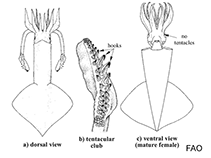Onykia robusta (Verrill, 1876)
Robust clubhook squid| Native range | All suitable habitat | Point map | Year 2050 |

|
| This map was computer-generated and has not yet been reviewed. |
| Onykia robusta AquaMaps Data sources: GBIF OBIS |
Google image | No image available for this species;
drawing shows typical species in Onychoteuthidae.
Classification / Names Common names | Synonyms | CoL | ITIS | WoRMS
Cephalopoda | Oegopsida | Onychoteuthidae
Environment: milieu / climate zone / depth range / distribution range Ecology
Pelagic; depth range 32 - 528 m (Ref. 101455). Subtropical; 61°N - 36°N, 145°E - 126°W (Ref. 275)
Distribution Countries | FAO areas | Ecosystems | Occurrences | Introductions
Northern Pacific and the Arctic. Subtropical to polar.
Length at first maturity / Size / Weight / Age
Maturity: Lm ? range ? - ? cm Max length : 200 cm ML male/unsexed; (Ref. 275); common length : 160 cm ML male/unsexed; (Ref. 97142); max. published weight: 50.0 kg (Ref. 275)
Life cycle and mating behavior Maturity | Reproduction | Spawning | Eggs | Fecundity | Larvae
Main reference
References | Coordinator | Collaborators
MarineSpecies.org. 2050. (Ref. 3477)
IUCN Red List Status
(Ref. 130435: Version 2024-2)
CITES status (Ref. 108899)
CMS (Ref. 116361)
Threat to humans
Human uses
Fisheries: of potential interest
| FishSource |
Tools
More information
Max. ages / sizes
Length-weight rel.
Length-length rel.
Length-frequencies
Mass conversion
Abundance
Internet sources
BHL | BOLD Systems | CISTI | DiscoverLife | FAO(Publication : search) | Fishipedia | GenBank (genome, nucleotide) | GloBI | Gomexsi | Google Books | Google Scholar | Google | PubMed | Tree of Life | Wikipedia (Go, Search) | Zoological Record



